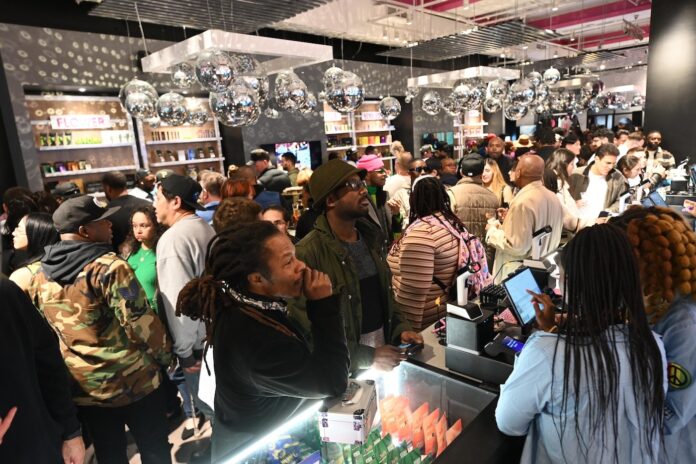In the cannabis industry, no day is more anticipated than April 20, or “4/20” in the vernacular. Often referred to as the industry’s “high holy day” or unofficial holiday, companies and individuals mark the day with product launches, promotional offers, and community events. Legal businesses seize opportunities to drive sales and create goodwill, making the period leading up to the “holiday” an ideal indicator of sales trends and challenges.
What will customers seek this year? How can you stock those products in sustainable amounts, and what strategies have proven most effective in attracting customers to stores and increasing their average spend? Here’s some historical perspective.
According to data from Treez, customer spending on and around 4/20 is consistently higher than during any other period in the year. In 2023, dispensaries hosted about 123 percent more shoppers than on any other single day, and the full week brought twice as many customers as the week prior.
Other cannabis-centric holidays like Green Wednesday and 710 (July 10, or “OIL day”) haven’t shown the same consistency or growth in customer count. In fact, both show a 13-percent reduction in customer count overall since 2020. During the same period, customer turnout on 4/20 climbed 25 percent, indicating the day’s enduring significance for cannabis-specific shopping.
This year, for the first time since before the coronavirus pandemic, 4/20 falls on a Saturday, so expectations around both general excitement and sales are heightened. Given that Fridays tend to be the biggest shopping days for cannabis anyway, retailers can look forward to an early surge in sales leading up to 4/20, which is likely to extend throughout the weekend. With nearly double the usual sales volume expected on 4/20, coupled with the weekend shopping surge, retailers can anticipate a three-day period that surpasses any other in 2024 by more than double.
Many customers will start shopping the week before the holiday, boosting sales for the entire week, while others reserve their 4/20 purchases for the day itself.
Specific strategies can help retailers convert curious 4/20 visitors into loyal customers who return all year long. To encourage new customers to visit, consider promoting beginner-friendly products and offering discounts. Train and incentivize staff to sign up customers for loyalty and email programs, and provide education about cashless payments to elevate average order values to maximize the lift.
Even with higher consumer turnout and increased order values, 4/20 isn’t guaranteed to be profitable if retailers over-discount or discount too broadly. Despite record customer and transaction count in 2023, both average order values (AOV) and average order profit (AOP)—two metrics retailers watch intently—were down significantly from peaks in 2021. AOV was down almost $10 from a high of about $98 in 2021, and AOP dropped about $4.25, or 14.25 percent. Not coincidentally, the average discount percent across stores on 4/20 in 2023 was the highest in recent years at 32.42 percent.
Strategic discounting and promotion require advanced consideration. It may be tempting to run a single percentage discount store-wide, but that could represent a missed opportunity. To set themselves up for success, retailers should offer deals specific to all major product types and at all price points. This will ensure the strategy calls different customer cohorts to action.
Assuming a dispensary will discount around 30 percent during the holiday, which gleans more useful information about the customer: one storewide discount or different discounts based on product type, brand affinity, or even time of day? In the second scenario, when the 4/20 dust settles, a retailer will have gained several fresh customer lists for remarketing purposes.
As they consider discounts, retailers must remain attuned to product trends and popularity. Product-type popularity on 4/20 has not changed more than 3 percent since last year, with flower consistently leading at 37 percent of purchases, followed by cartridges at 24 percent and pre-rolls at 17 percent. Notably, pre-rolls are the product type that has grown most in popularity year over year. In 2021, the category accounted for 10 percent of total product sales.
Once retailers have mapped out their discount strategy, the next step is to work closely with brands to set up a credit system for the planned discounts and ensure sufficient stock will be on hand.
Retailers should negotiate front-loaded discounts wherever possible to allow for easier data interpretation as opposed to back-ended credits or margin protection. 4/20 is synonymous with heavy discounting and increased overhead, but working with suppliers ahead of time can alleviate some of the impact of increased expense.
On 4/20 last year, customers opted for cashless payments 28 percent of the time—a 65-percent increase over 2022 levels. The cashless uptick correlates with an increase in average order values. This underscores the importance of offering diverse payment options to cater to evolving consumer preferences and behaviors. Fewer and fewer people carry cash, and dispensary customers are becoming accustomed to the convenience of alternative payment methods.
Given cashless payments’ impact on average order value and revenue, retailers should consider offering discounts or increased loyalty points for customers who take advantage of those methods. Retailers also should ensure their cashless payment options are connected to their point-of-sale system (for better internal visibility) and redundant.
As 4/20 becomes more ingrained in mainstream culture, retailers can use the day strategically for growth and exposure. By leveraging data, strategic planning, and innovative approaches, retailers can drive growth and foster a thriving market.

Andrew Hodshire is a retail analytics consultant and member of the professional services team at Treez. With a background in retail systems and inventory control at dispensaries, he focuses on helping customers leverage Treez analytics and tools to improve operational efficiencies.
- SEO Powered Content & PR Distribution. Get Amplified Today.
- PlatoData.Network Vertical Generative Ai. Empower Yourself. Access Here.
- PlatoAiStream. Web3 Intelligence. Knowledge Amplified. Access Here.
- PlatoESG. Carbon, CleanTech, Energy, Environment, Solar, Waste Management. Access Here.
- PlatoHealth. Biotech and Clinical Trials Intelligence. Access Here.
- Source: https://mgmagazine.com/business/retail-merchandise/brace-for-impact-420-likely-to-set-new-records/




